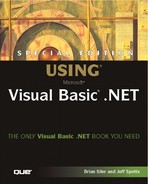Chapter 15. Multiple Document Interface (MDI) Applications
In this chapter
Creating the Parent Form for the Sample Application
As you begin to write more advanced Visual Basic applications, at some point you will probably want to develop applications that contain a number of forms that need to be organized in a structured manner. If so, you may want to think about creating a Multiple Document Interface (MDI) application. The MDI standard allows your programs to work with multiple forms contained within a parent form. Using the MDI makes your interface cleaner than one that has independent forms scattered about the screen.
The MDI standard can enhance your programs in two ways. First, you can have one container form that acts as the background for your overall application. If a user moves the container form, the child forms contained inside move as well, which helps keep your application’s interface organized and self-contained. Second, and perhaps even more powerful, your users can work on multiple documents at one time. MDI applications allow the use of multiple instances of the same form, which can add a great deal of power and flexibility to your programs.
